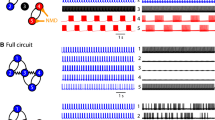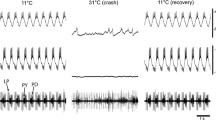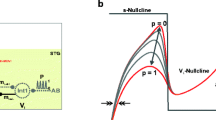Summary
What have we learned about behavior from neuromodulatory studies of the crustacean stomatogastric system? The emphasis of this paper has been on the analysis of one single class of behaviors (rhythmic) in terms of microcircuitry (synaptic connections between identified neurons). But in the general case, all behaviors result from the generation of spatio-temporal patterns by the central nervous system. How individual nerve cells interact with each other to produce such patterns is of fundamental interest. We know from work on simple networks that it is possible to link the circuitry of the nervous system with behavior in a precise way, and that instead of a large number of dedicated circuits, behaviors can be altered by chemically adjusting the functional properties of the neuronal elements. One circuit can be configured to perform a variety of different behaviors by activating neurons which contain neuromodulatory substances or in response to neurohormones circulating in the hemolymph. At present we know only a few of the ways neuromodulatory neurons are triggered to release their contents onto the neurons making up CPGs.
The findings described here raise many questions. What are the parameters which control the distribution of neuromodulatory substances throughout the nervous system? What happens when more than one neuromodulator is present? At the cellular level, what mechanisms are involved in transforming each neuron from one functional state to another, and then how does the entire constellation of changes give rise to a new output? It is important to answer such questions in reduced networks, because there are presently no techniques available to answer them in the more complex networks of the brain. While there is no question that modulatory activity occurs in the brain, whether or not the principles which have been discovered by using “simple” invertebrate circuits scale up to vertebrate circuits remains an intriguing question.
Similar content being viewed by others
References
Arshavsky YI, Beloozerova GN, Orlovsky GN, Panchin YV, Poplova GA (1985) Control of locomotion in marine mollusc Clione limicina. III. On the origin of locomotory rhythm. Exp Brain Res 58:273–284
Beltz B, Eisen JS, Flamm R, Harris-Warrick R, Hooper S, Marder E (1984) Serotinergic innervation and modulation of the stomatogastric ganglion of three decapod crustaceans (Homarus americanus, Cancer irroratus, and Panulirus interruptus). J Exp Biol 109:35–54
Benjamin PR, Elliott CJH (1989) Snail feeding oscillator: The central pattern generator and its control by modulatory interneurons. In: Jacklet J (ed) Neuronal and cellular oscillators. Dekker, New York, pp 173–214
Brown TG (1911) The intrinsic factors in the act of progression in the mammal. Proc R Soc Lond B 84:308–319
Calabrese RL, Arbas EA (1989) Central and peripheral oscillators generating heartbeat in the leech Hirudo medicinalis. In: Jacklet J (ed) Neuronal and cellular oscillators. Marcel Dekker, New York, pp 237–268
Claiborne BJ, Selverston AI (1984) Histamine as a neurotransmitter in the stomatogastric nervous system of the spiny lobster. J Neurosci 4: 708–721
Delcomyn F (1980) Neural basis of rhythmic behavior in animals. Science 210:492–498
Dickinson P (1989) Modulation of simple motor patterns. Semin Neurosci 1:15–24
Dickinson PS, Marder E (1989) Peptidergic modulation of a multioscillator system in the lobster. I. Activation of the cardiac sac motor pattern by the neuropeptides proctolin and red pigment concentrating hormone. J Neurophysiol 61:833–844
Dickinson PS, Moulins M (1993) Interactions and combinations between different networks in the stomatogastric nervous system. In: Harris-Warrick RM, Marder E, Selverston AI, Moulins M (eds) Dynamic biological networks: The stomatogastric nervous system. MIT Press, Cambridge MA, pp 139–160
Dickinson PS, Mecsas C, Marder E (1990) Neuropeptide fusion of two pattern generator circuits. Nature (Lond) 344:155–158
Dowling JE (1989) Neuromodulation in the retina: the role of dopamine. Semin Neurosci 1:35–43
Flamm RE, Harris-Warrick RM (1986) Aminergic modulation in the lobster stomatogastric ganglion. II. Target neurons of dopamine, octopamine and serotonin within the pyloric circuit. J Neurophysiol 55:866–881
Getting PA (1989) Emerging principles governing the operation of neural networks. Annu Rev Neurosci 12:185–204
Getting PA, Dekin MS (1985) Tritonia swimming: A model system for integration within the rhythmic motor systems. In: Selverston AI (ed) Model neural networks and behavior. Plenum, New York, pp 3–20
Harris-Warrick RM, Marder E (1991) Modulation of neural networks for behavior. Annu Rev Neurosci 14:39–57
Harris-Warrick RM (1988) Chemical modulation of central pattern generators. In: Cohen AH, Rossignol S, Grillner S (eds) Neural control of rhythmic movements. John Wiley, New York, pp 285–331
Harris-Warrick RM, Nagy F, Nusbaum MP (1992) Neuromodulation of stomatogastric networks by identified neurons and transmitters. In: Harris-Warrick RM, Marder E, Selverston AI, Moulins M (eds) Dynamic biological networks: The stomatogastric nervous system. MIT Press, Cambridge Mass, pp 87–137
Heinzel HG (1988) Gastric mill activity in the lobster. I. Spontaneous modes of chewing. J Neurophysiol 59:528–550
Hooper SL, Moulins M (1989) Switching of a neuron from one network to another by sensory-induced changes in membrane properties. Science 244:1587–1589
Kaczmarek LK, Levitan IB (1987) Neuromodulation: The biochemical control of neuronal excitability. Oxford University Press, New York
Katz PS, Harris-Warrick RM (1990) Neuromodulation of the crab pyloric central pattern generator by serotonergic/cholinergic proprioceptive afferents. J Neurosci 10:1495–1512
Kravitz EA (1988) Hormonal control of behavior: amines and the biasing of behavioral output in lobsters. Science 241:1775–1780
Larson BA, Vigna SR (1983) Species and tissue distribution of cholecystokinin/gastrin-like substances in some invertebrates. Gen Comp Endocrinol 50:469–475
Marder EE, Hooper SL, Eisen JS (1987) Multiple neurotransmitters provide a mechanism for the production of multiple outputs from a single neuronal circuit. In: Edelman GM, Gall WE, Cowan MW (eds) Synaptic function. John Wiley, New York, pp 305–327
Maynard DM, Selverston AI (1975) Organization of the stomatogastric ganglion in the spiny lobster IV. The pyloric system. J Comp Physiol 100:161–182
Meyrand P, Simmers J, Moulins M (1991) Construction of a pattern-generating circuit with neurons of different networks. Nature (Lond) 351:60–63
Miller JP, Selverston AI (1979) Mechanisms underlying pattern generation in lobster stomatogastric ganglion as determined by selective inactivation of identified neurons IV. Network properties of pyloric system. J Neurophysiol 48:1416–1432
Mulloney B, Selverston AI (1974a) Organization of the stomatogastric ganglion in the spiny lobster I. Neurons driving the lateral teeth. J Comp Physiol 91:1–32
Mulloney B, Selverston AI (1974b) Organization of the stomatogastric ganglion in the spiny lobster III. Coordination of the two subsets of the gastric system. J Comp Physiol 91:53–78
Nagy F, Dickinson PS (1983) Control of a central pattern generator by an identified modulatory interneuron in crustacea. I. Modulation of the pyloric motor output. J Exp Biol 105:33–58
Nusbaum MP, Marder E (1989) A modulatory proctolin-containing neuron (MPN). I. Identification and characterization. J Neurosci 9:1591–1599
O'Shea M (1985) Neuropeptide function: the invertebrate contribution. Ann Rev Neurosci 8:171–198
Rezer E, Moulins M (1983) Expression of the pyloric pattern generator in the intact animal. J Comp Physiol 153:17–28
Selverston AI (1980) Are central pattern generators understandable? Brain Behav Sci
Selverston AI, Mulloney B (1974) Organization of the stomatogastric ganglion in the spiny lobster II. Neurons driving the medial tooth. J Comp Physiol 91:33–51
Selverston AI, Russell DF, Miller JP, King DG (1976) The stomatogastric nervous system: Structure and function of a small neural network. Prog Neurobiol 7:215–290
Spirito CP (1975) Organization of the crayfish oesophageal nervous system. J Comp Physiol 102:237–249
Turrigiano GG, Selverston AI (1989) Cholecystokinin-like peptide is a modulator of a crustacean central pattern generator. J Neurosci 9:2486–2501
Turrigiano GG, Selverston AI (1990) A cholecystokinin-like hormone activates a feeding-related neural circuit in lobster. Nature (Lond) 344:866–868
Turrigiano GG, Selverston AI (1991) Distribution of cholecystokinin-like immunoreactivity within the stomatogastric nervous systems of four species of decapod Crustacea. J Comp Neurol 305:164–176
Weimann JM, Meyrand P, Marder E (1991) Neurons that form multiple pattern generators: Identification and multiple activity patterns of gastric/pyloric neurons in the crab stomatogastric system. J Neurophysiol 65:111–122
Author information
Authors and Affiliations
Rights and permissions
About this article
Cite this article
Selverston, A. Modulation of circuits underlying rhythmic behaviors. J Comp Physiol A 176, 139–147 (1995). https://doi.org/10.1007/BF00239917
Accepted:
Issue Date:
DOI: https://doi.org/10.1007/BF00239917




